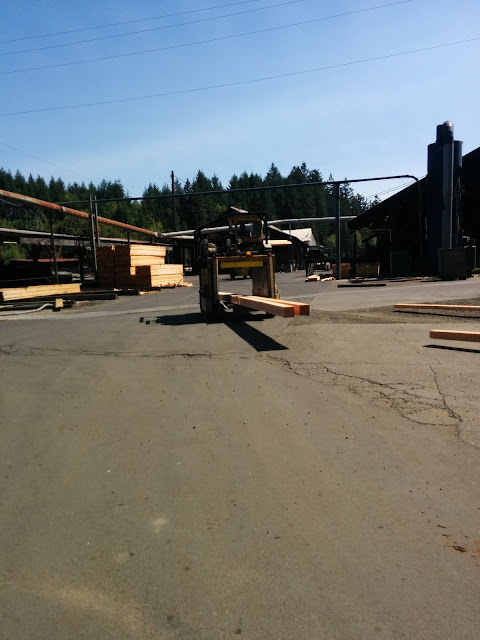On a whim I decided this morning to go on the Hull-Oakes lumber mill bus tour despite the mill being 2 hours away in Monroe, OR.
The cut trees are stored in the log pond.
Since these long pieces of wood are dramatically easier to move around when in the water, they use a small motor boat to do so. In the background is a wigwam burner which used to be used for burning wood chips, saw dust, and bark, but that practice was stopped years ago for air quality reasons.
To become useful wood beams, the trees are feed through a rotary debarker.
The debarker at Hull-Oakes happens to be really big with an opening of 72 inches diameter. There are only 5 of these in the US, and only one is operational. The other 4 are in storage at the mill and provide spare parts...
 |
| For debarking the teeth on the ring fold in and scratch the bark of the tree |
Chains carry the debarked trees to the head saw in the main mill building.
The trees are fed to a sled which acts as traverser and feeds the wood through the head saw, which is basically a huge single direction band saw. The saw is visible behind the guy with the red cap.
The sled and all its hydraulics to e.g. rotate the tree, are controlled from a control cab right next to the saw.
Boards are pushed to the side and fed through a trim saw. In the photo below the head saw and sled are in the back on the left. The trim saw is in the middle on the right. A board with off-cuts has just left the trim saw.
The rough cut wood beams and larger boards are sorted in a large shed attached to the mill building. Note the long beam in the picture. It is about 50 ft long. This mill can handle beams up to 85 ft long! Modern mills focus on standard lengths of lumber, and thus are usually not equipped to make lumber any longer than the 12 ft one finds at Home Depot.
Cool critters move the wood to the planing building.
The planer was being reconfigured when we came through here, so we didn't see it in operation.
Planed boards are sorted, graded, and stacked.
Fork lifts move completed stacks to the shipping yard.
From the shipping yard trucks will transport the finished wood to the customer.
Hull-Oakes used to be rail-served, but hasn't been for several years now. The tracks are still there. Even the ditch that used to be used for spotting box cars and loading wood through the lumber door from above up to the 1950's still has its rails.
There is a separate planing machine for large beams, too.
All the sawdust is collected in large bins and trucked to a nearby papermill. The bark is similarly sold to become mulch.
A special treat for us was to see how the crew swapped out the saw band from the head saw. Here is the replacement saw band ready to go into production.
The mill shuts down, doors to the saw shop are opened, and the saw band is pulled into the saw shop.
The used saw band is moved aside and the fresh one installed. The whole procedure takes 8 minutes and is done every 2 hours. The used saw band gets inspected in the saw shop and all teeth straightend and sharpend for optimal performance.
It was impressive to see this mill in operation. There is quite a bit of manual work augmented with technology where it makes sense. One could see the professionalism of the employees and the pride in their work. One could also see how easy it is to get hurt around this big and powerful machinery. I was glad that Hull-Oakes made this tour possible for a bunch of railroad enthusiasts, and let us get a close-up view of its operations.
























No comments:
Post a Comment